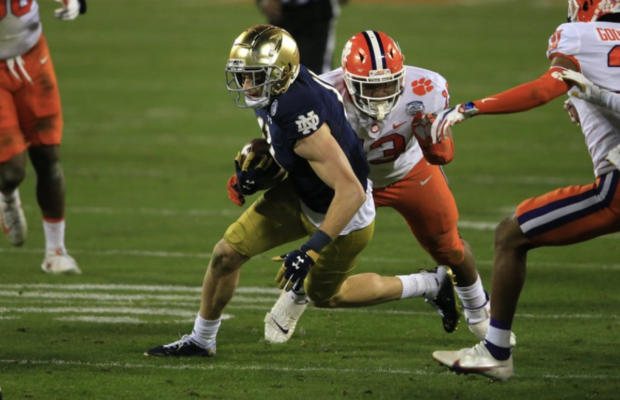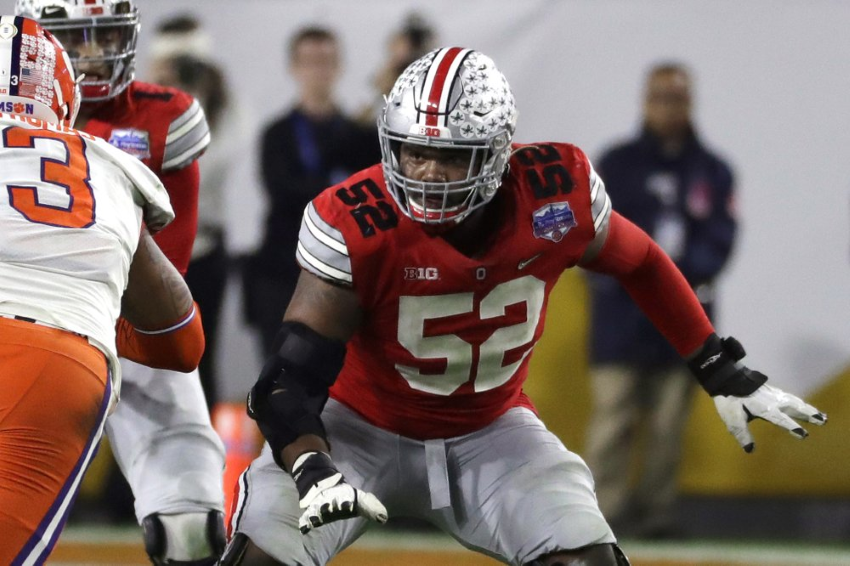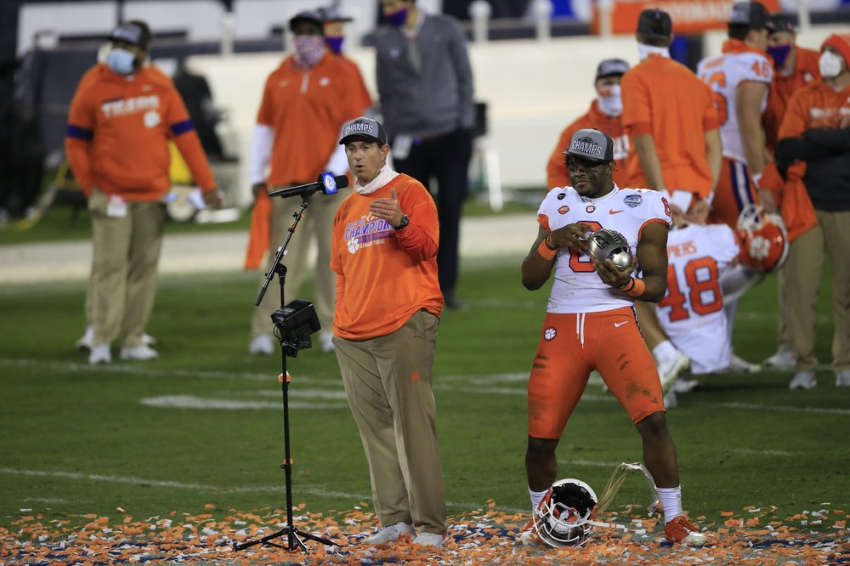Sacrifice and stress: How players handled season of COVID-19

By Ralph Russo
The Saturday night after winning an afternoon home game is one of the best times to be a college football player.
Family and loved ones usually await with congratulatory hugs. Then there is a nice dinner and maybe more celebrating with teammates and friends. Few things get a college town hopping like a football victory.
But not this season.
“I’d pretty much go home, lay on my couch, watch (video) cut-ups of the game like two or three times. Probably go pick up some food,” Notre Dame offensive tackle Liam Eichenberg said.
To play through a pandemic, players had to sacrifice much of their lives away from the game, along with some of the best aspects of being part of a team.
To reach the playoff, No. 1 Alabama, No. 2 Clemson, No. 3 Ohio State and No. 4 Notre Dame had to go a combined 37-2 on the field and keep the coronavirus at bay.
“It’s been incredibly challenging,” Clemson coach Dabo Swinney said. “I just tell them, don’t give up what they want most for what they may want at the moment. It’s just really that simple. And the teams that do this the best and manage this the best, that’s who’s going to finish the best.”
Doing so required lots of COVID-19 testing, and the anxiety that comes with knowing the next test could be the one that puts a season on hold, and little time spent with anyone outside the team.

Ohio State OL Wyatt Davis (52) during Fiesta Bowl NCAA game against Clemson in Glendale, Ariz., in this Saturday, Dec. 28, 2019, file photo Photo: AP Photo/Rick Scuteri, File
Even when the players were together, there were obstacles — both literal and figurative — to bonding with teammates.
“Eating together as a team, we do it with a glass divider between us,” Notre Dame receiver Ben Skowronek said Monday during media Zoom sessions for the CFP. “I miss those meals and just getting to know people in the locker room. All that stuff.”
Another oddity brought on by the pandemic: Four days before the New Year’s Day semifinals, the playoff participants were still on their respective campuses.
Alabama faces Notre Dame in the relocated Rose Bowl at the home of the Dallas Cowboys in Arlington, Texas. Clemson and Ohio State meet at the Sugar Bowl in New Orleans in a rematch of last year’s thrilling semifinal.
Typically, teams arrive at the site of their semifinal about five or six days in advance. The bulk of the preparation for the game has already been done. At the host city, there are media availabilities, practices and a walkthrough or two at the stadium. There are activities away from the field, outings and meals. Plus, some unsupervised time for the players.
“Going to a bowl site is always what you work for,” Clemson linebacker Baylon Spector said. “It’s very fun. You get to do a lot of different things.”
As for this week, Spector said:
“Tonight, we got bingo night. We’re enjoying it as much as we can.”
The teams will arrive at the host cities on Wednesday.
Alabama and Clemson gave players some freedom to be with family on Christmas and other breaks this season, but with strict orders to mask up and keep their distance, even with loved ones.
Notre Dame and Ohio State were more cautious, keeping their players on campus over the recent holiday weekend.
There is still more COVID-19 testing to be done, and each team has learned through experience that nothing is guaranteed this season.
“It was really stressful, but the main thing was trying to keep a level mind and do the things that we needed to do in order to succeed,” Alabama linebacker Dylan Moses said.
Alabama had one game postponed because of an opponent’s COVID-19 outbreak, and it played the Iron Bowl against Auburn without coach Nick Saban after he tested positive.
Notre Dame had a virus outbreak pause its season for about two weeks in late September.

Clemson HC Dabo Swinney addresses the media as Clemson LB Mike Jones Jr. (6) gestures behind him following their 34-10 victory over Notre Dame at the Atlantic Coast Conference championship NCAA college football game, Saturday, Dec. 19, 2020, in Charlotte, N.C. Photo: AP Photo/Brian Blanco
Clemson star Trevor Lawrence missed two games, including the Tigers’ regular-season loss to Notre Dame, after contracting COVID-19.
Ohio State played only six games after the Big Ten started in late October, losing two games because of opponents’ COVID-19 issues and one because of their own.
“What stood out to me the most, what I find to be the hard thing is how one day you can practice and the next day you’re out a couple weeks because of COVID,” said Ohio State All-American offensive lineman Wyatt Davis, who has not contracted the virus. “It’s just a day-to-day thing. Holding guys to a standard that you can’t go out and hang out with people. You can’t go see your family.”
Josh Myers, Davis’ friend and linemate, did contract COVID-19. Myers said 10 days in isolation was terrible, mostly because of the boredom and inactivity. He said he has had no lingering effects of the virus.
Tigers linebacker Mike Jones said winning made the restrictions easier to live with and Clemson did a good job of implementing and enforcing protocols. After a while it felt normal, but it was anything but the usual college experience.
“You know it’s kind of weird not being able to hang out with your friends all the time,” Jones said. “Not being able to see your family after the game. Not going home during your bye week because you don’t want to risk it. (No) celebrating after wins and stuff like that. Being with your buddies on the bus to away games.
“It’s been a lot. We’ve all had these trials and managed to get through them.”
___
Follow Ralph D. Russo at https://twitter.com/ralphDrussoAP and listen at https://westwoodonepodcasts.com/pods/ap-top-25-college-football-podcast/